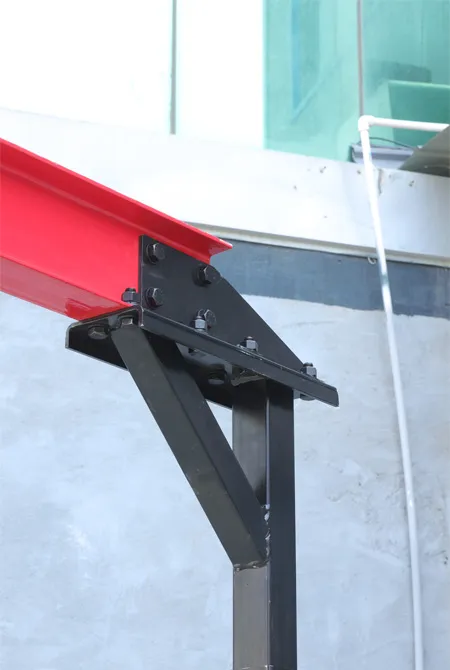vertical gantry
Understanding the Vertical Gantry Innovations in Engineering and Construction
The vertical gantry system has emerged as a critical innovation in the field of engineering and construction, demonstrating versatility and efficiency in handling various tasks. As construction projects become increasingly complex and the need for precision grows, vertical gantries offer a solution that meets these challenges head-on. This article explores the functionalities, advantages, applications, and future prospects of vertical gantry systems.
What is a Vertical Gantry?
A vertical gantry consists of a framework that provides support to a hoisting mechanism. It typically includes vertical posts, a horizontal beam (or gantry), and can be raised or lowered as needed to accommodate different loads and heights. This engineering marvel allows workers to lift, move, and place heavy materials with ease and precision.
These systems can vary in size and capacity, ranging from small units used in workshops to large-scale constructions involving massive structures. Vertical gantries can be fixed or movable, and their designs are often customized to meet specific project requirements.
Functionalities of Vertical Gantries
The primary function of a vertical gantry is to lift heavy loads, but its capabilities extend beyond mere lifting
. A vertical gantry can be equipped with various tools and attachments to serve different purposes1. Lifting and Moving The most obvious function is to lift and transport heavy materials, such as steel beams, prefabricated components, or concrete panels, efficiently around construction sites.
2. Positioning The precision in positioning allows for accurate assembly of structures, vital in deep foundation work or when aligning elements in high-rise buildings.
3. Support for Assembly Tasks Vertical gantries can serve as platforms for workers, facilitating assembly tasks at various heights, thus improving productivity and safety.
4. Automation Integration Many modern vertical gantries are compatible with automated systems, which can enhance efficiency through reduced labor demands and increased consistency.
Advantages of Vertical Gantries
The use of vertical gantries in construction and manufacturing processes provides numerous advantages
vertical gantry

1. Safety By minimizing manual handling of heavy materials, gantries significantly reduce the risk of workplace injuries. They are designed with safety features that ensure stability during operations.
2. Efficiency Vertical gantries allow for smooth workflows by streamlining the process of lifting and transporting materials. This efficiency can result in shorter project timelines and reduced labor costs.
3. Space Optimization These systems maximize space utilization, enabling work in constricted environments, which is often the case in urban construction projects.
4. Adaptability New designs and attachment systems have made vertical gantries adaptable to various applications, whether for general construction, shipbuilding, or even theatrical productions.
5. Cost-Effectiveness Although the upfront investment might be significant, the long-term savings from reduced labor costs and increased safety frequently make vertical gantries a cost-effective solution.
Applications in Various Industries
Vertical gantries find applications across a spectrum of industries
- Construction Used in both commercial and residential projects, they facilitate the lifting and moving of heavy materials like steel girders and precast slabs. - Manufacturing In factories, vertical gantries assist in the assembly lines, enabling the handling of large components, thus improving workflow processes. - Shipbuilding These systems are vital in the construction and repair of ships, allowing for the maneuvering of large sections with precision.
- Aerospace In the aerospace sector, vertical gantries aid in the assembly of aircraft by providing crucial support and integration capabilities.
The Future of Vertical Gantries
As technology continues to advance, the capabilities of vertical gantries are set to expand further. The integration of smart technologies, such as IoT sensors and AI-driven automation, will enhance operational efficiency and precision. Future vertical gantries will likely feature improvements in their designs, making them even lighter yet more robust.
In conclusion, vertical gantries represent a significant advancement in construction and manufacturing. Their ability to enhance safety, efficiency, and adaptability makes them essential tools in modern engineering practices. As industries evolve, vertical gantries will undoubtedly play a crucial role in shaping the future of construction and material handling.
-
Unlock Seamless Relocation with Our Heavy Equipment Moving ExpertiseNewsJun.06,2025
-
Unleash Unrivaled Flexibility with Our Adjustable Gantry CraneNewsJun.06,2025
-
Unleash Heavy-Duty Efficiency with Our Industrial Gantry Crane SolutionsNewsJun.06,2025
-
Revolutionize Steel Handling with Our Magnetic Lifter RangeNewsJun.06,2025
-
Master Equipment Mobility with Premium Machinery Mover SolutionsNewsJun.06,2025
-
Elevate Your Material Handling with Magnetic Lifter TechnologyNewsJun.06,2025
-
YS Permanent Lifting Magnets: The Smarter Way to Handle SteelNewsMay.22,2025
